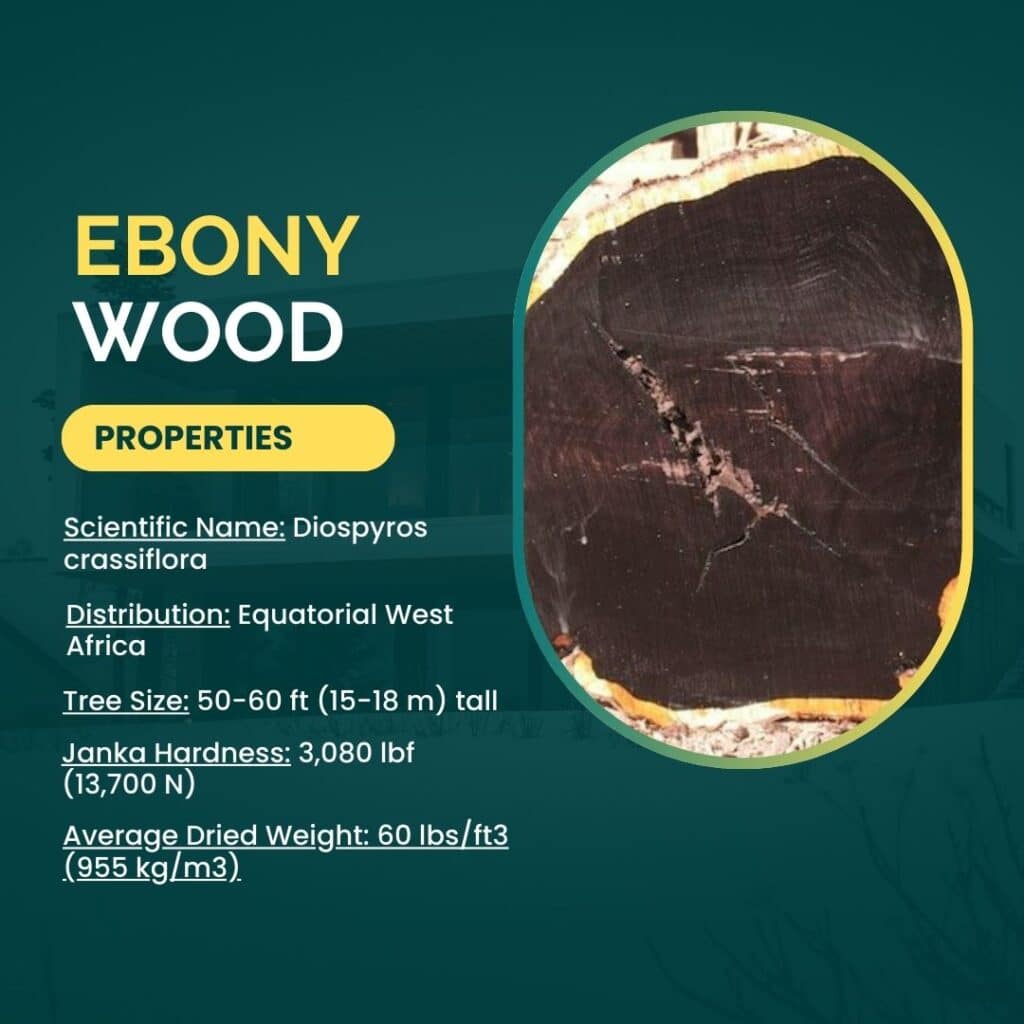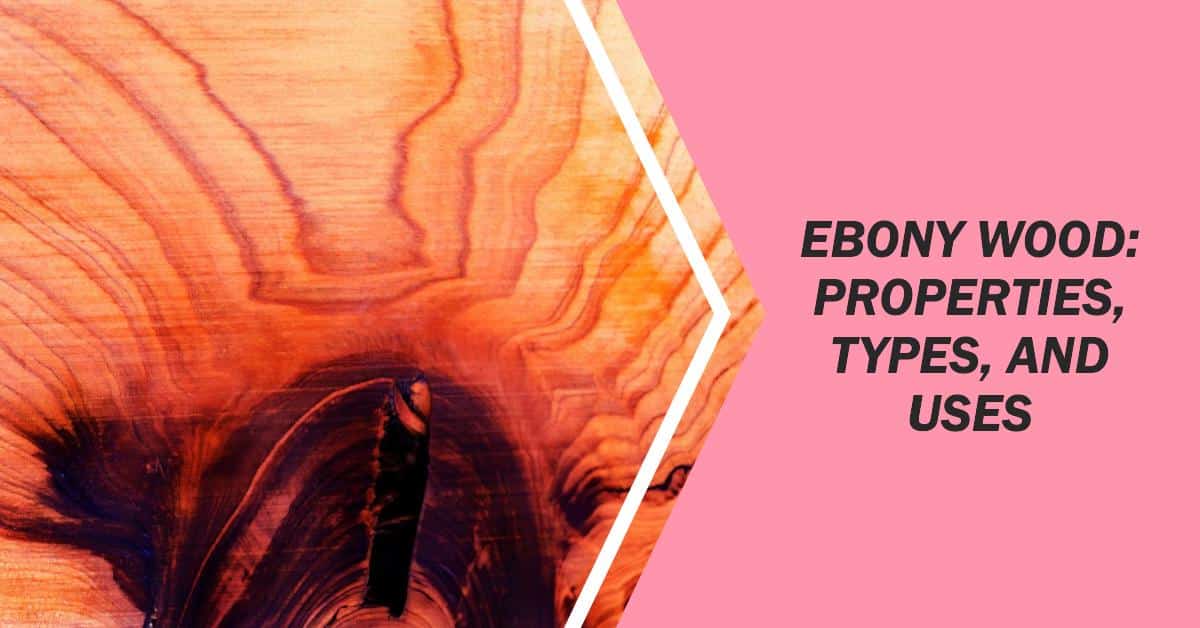From the majestic Gaboon Ebony wood of Africa to the exotic Macassar Ebony of Southeast Asia, each species tells a story of rarity and prestige. With an average height of 20-30 feet and a lifespan of over 500 years, ebony trees command reverence for their longevity and resilience.
But it’s not just its beauty and durability that set ebony apart – it’s also its rich history and cultural significance. Once revered by royalty for its ornamental properties and believed to possess mystical powers, ebony wood symbolizes wealth and power for centuries. Ebony wood scarcity and exceptional properties with its natural black or dark brown hue make it a prized possession for craftsmen and collectors alike. In this guide, we will explore different types of ebony wood with their properties and uses.
Common Properties of Ebony Wood
Ebony wood possesses a unique set of properties that distinguish it as one of the most prized materials. Here are some of the key ebony wood properties:

Hardness and Density:
Ebony wood is renowned for its exceptional hardness and density, making it one of the toughest woods on the planet. Its dense composition contributes to its remarkable strength, allowing it to withstand heavy use and resist wear and tear over time.
Distinctive Grain:
Characterized by its striking striped grain pattern, which adds depth and visual interest to finished pieces. The grain varies from intense black to dark brown, creating a captivating contrast against the wood’s rich red and brown hues.
Rich Coloration:
Ebony wood boasts a natural black or dark brown color, with brown being the predominant hue in most species. The deep, lustrous tones of ebony lend an air of sophistication and elegance to any project, enhancing its aesthetic appeal.
Durability and Stability:
Due to its hardness and density, ebony wood exhibits excellent durability and stability. It is resistant to termites, insects, and decay, making it an ideal choice for long-lasting furniture, flooring, and decorative items that require strength and longevity.
Longevity:
Ebony trees have an impressive lifespan, with some specimens living for over five centuries or more. This longevity reflects the wood’s resilience and ability to endure for generations.
Workability:
Despite its hardness, it is prized for its workability and machinability. It can be cut, carved, and shaped with precision, allowing artisans to create intricate details and fine craftsmanship in their projects.
Weight:
Ebony wood is known for its considerable weight, which adds to its sense of solidity and luxury. While its density contributes to its durability, it also means that ebony is heavier than many other types of wood, requiring careful handling during transportation and construction.
Popular Types of Ebony Wood
1. Gaboon Ebony
Gaboon Ebony, also known as West African ebony, is a special type of wood found in Africa. It is an immensely popular wood because of its jet-black color and smoothness. The trees are tall, almost like giants, and their trunks can be as wide as three feet. It is so strong that it can last long without getting damaged by bugs or rot. That’s why people use it to make fancy furniture, guitars, and even cool jewelry boxes! But here’s the thing – because Gaboon Ebony is so rare and special, it can be expensive.
Properties
Scientific name: Diospyros crassiflora
Distribution: West Africa, mainly near the equator
Color: Deep, rich black
Tree Size: 50-60 ft tall, 2-3 ft trunk diameter
Janka Hardness: 3,080 lbs
Uses: Furniture, Musical Instruments, Ornamental Woodworking, Luxury Accessories, Knife Handles and Tool Grips
2. Ceylon Ebony
The heartwood of Ceylon Ebony is jet-black, often with dark brown streaks and fine texture, creating a striking contrast that adds to its aesthetic appeal. It is one of the densest and hardest woods in the world, making it incredibly durable and resistant to wear, decay, and insect infestation. Moreover, due to overexploitation and habitat loss, genuine Ceylon Ebony has become increasingly rare and is now protected under various conservation regulations.
Scientific name: Diospyros ebenum
Distribution: Sri Lanka, Southeast Asia
Color: Jet black
Tree Size: 50-80 ft tall, 1-2 ft trunk diameter
Janka Hardness: 2,430 lbf
Uses: Furniture, musical instruments
3. Macassar Ebony
Macassar Ebony derives its name from the bustling city of Macassar (also spelled Makassar) on the Indonesian island of Sulawesi. These trees can be as tall as 65 feet and what sets them apart from its ebony relatives is its wood grain pattern with wider streaks ranging from rich browns to deep blacks.
Scientific name: Diospyros celebica
Distribution: Southeast Asia
Color: dark brown to black stripes
Tree Size: 50-65 ft tall, 1.5 ft trunk diameter
Janka Hardness: 3,220 lbf
Uses: high-end furniture, musical instruments, sculptures, knife handles, and jewelry
4. Queensland Ebony
It is a species of ebony wood native to the rainforests of Queensland, particularly thriving along the coastal regions of New South Wales, Australia. Characterized by its distinctive orange-to-yellow fruits, Queensland Ebony presents a striking contrast against its lush green foliage. This diminutive yet sturdy plant yields remarkable wood highly prized for its strength and durability and is popular for making high-quality cabinets.
Scientific name: Diospyros humilis
Distribution: Found exclusively in Australia
Color: dark hue with black streaks
Tree Size: 6 to 15 feet tall
Janka Hardness: 2,080 to 2,230 lbf
Uses: luxurious and long-lasting furniture pieces
5. Brazilian Ebony
This ebony wood type is a species of flowering tree native to the Atlantic Forest region of Brazil. The heartwood of Brazilian Ebony displays deep shades of black with occasional dark brown streaks, creating a captivating contrast against its pale sapwood.
Scientific name: Swartzia panacoco
Distribution: tropical forests of Brazil
Color: rich purplish-brown to nearly black hues
Tree Size: heights of up to 100 feet (30 meters)
Janka Hardness: 3,150 lbf (14,000 N)
Uses: fingerboards and bridges on guitars and violins
6. Mun Ebony
Mun Ebony, scientifically known as Diospyros mun, is a species of flowering plant belonging to the ebony family, Ebenaceae. It is native to Southeast Asia, particularly Thailand, Myanmar, Laos, and Vietnam. The wood of Mun Ebony is highly prized for its deep black color and dense, fine grain, making it a sought-after material for high-quality furniture, cabinetry, and musical instruments
Scientific name: Diospyros mun
Distribution: Laos and Vietnam
Color: occasional dark brown streaks with lighter tone sapwood
Tree Size: 35 to 50 ft. tall
Janka Hardness: 3,000 lbf
Uses: musical instruments, veneering, traditional crafts and carvings
7. Black and White Ebony
Also known as pale moon ebony, is a rare ebony wood type native to the regions of Southeast Asia, including countries like Myanmar, Thailand, and Laos. As its name suggests, Black and White Ebony is known for its distinctive coloration, featuring a stark contrast between dark black heartwood and creamy white sapwood. This wood is highly resistant to wear and abrasion, ensuring longevity in various applications making it an expensive affair.
Scientific name: Diospyros embryopteris
Distribution: Southeast Asia
Color: pale straw with darker black streaks
Tree Size: 50-115 ft tall, 1-3 ft trunk diameter
Janka Hardness: 1,780 lbf
Uses: veneers, inlays, and decorative items
8. Mauritius Ebony
Mauritius Ebony is a species of flowering plant belonging to the ebony family, Ebenaceae. With its interlocked grain pattern it was highly sought-after for its use in furniture-making, cabinetry, and decorative woodwork. However, due to its habitat destruction, Mauritius Ebony is now critically endangered.
Scientific name: Diospyros tessellaria
Distribution: Mauritius
Color: deep brown to nearly black
Tree Size: upto 65 feet tall
Janka Hardness: 3,000 lbf
Uses: musical instruments, and ornamental woodwork
9. Myrtle Ebony
Recognizable by its elegant white and red flowers, Myrtle Ebony wood is a rare and distinctive species of tree native to the tropical regions of Queensland, Australia. Its reddish-brown to purplish heartwood sets it apart, making it a prized material for fine woodworking and ornamental purposes. Furthermore, it stands out as one of the rarest trees within the ebony genus.
Scientific name: Diospyros pentamera
Distribution: New South Wales to the Atherton Tableland, Australia
Color: reddish-brown to purplish heartwood
Tree Size: 50 to 80 feet tall
Janka Hardness: 2,000 to 2,400 lbf
Uses: Furniture, Flooring, Art and Sculpture
10. Coromandel Ebony
Coromandel Ebony is mostly found in the tropical forests of South India, Sri Lanka, and parts of Southeast Asia. It holds a significant place in the history of fine woodworking and craftsmanship. The wood is commonly used as tobacco wrappings, its leaves have also been traditionally employed in herbal remedies for ailments such as malaria and other related diseases.
Scientific name: Diospyros melanoxylon
Distribution: India and Sri Lanka
Color: lustrous black hue
Tree Size: 30 to 60 feet tall
Janka Hardness: 3220 lbf
Uses: craftsmanship and medicinal use
Whether admired for its striking beauty, cherished for its cultural significance, or revered for its medicinal properties, ebony wood remains an enduring symbol of craftsmanship, resilience, and natural wonder. For more information about ebony wood or any other wood for that matter just keep exploring “Timber Explore“, your ultimate timber wood information partner.

